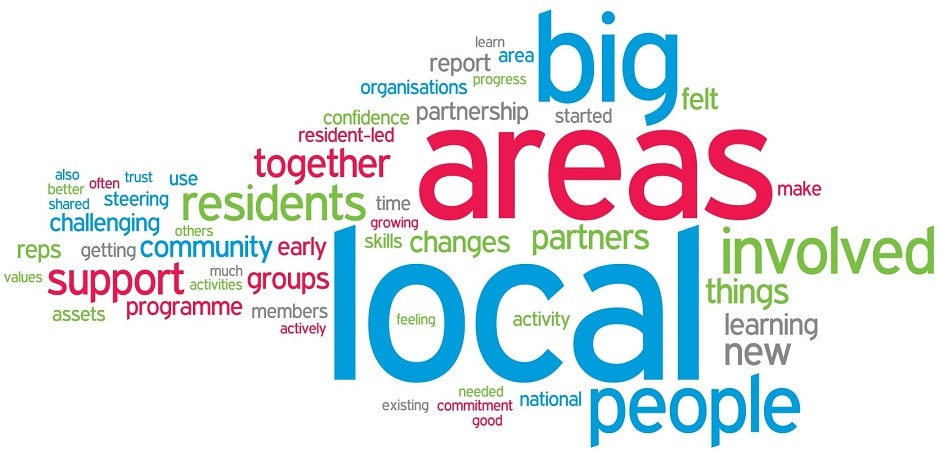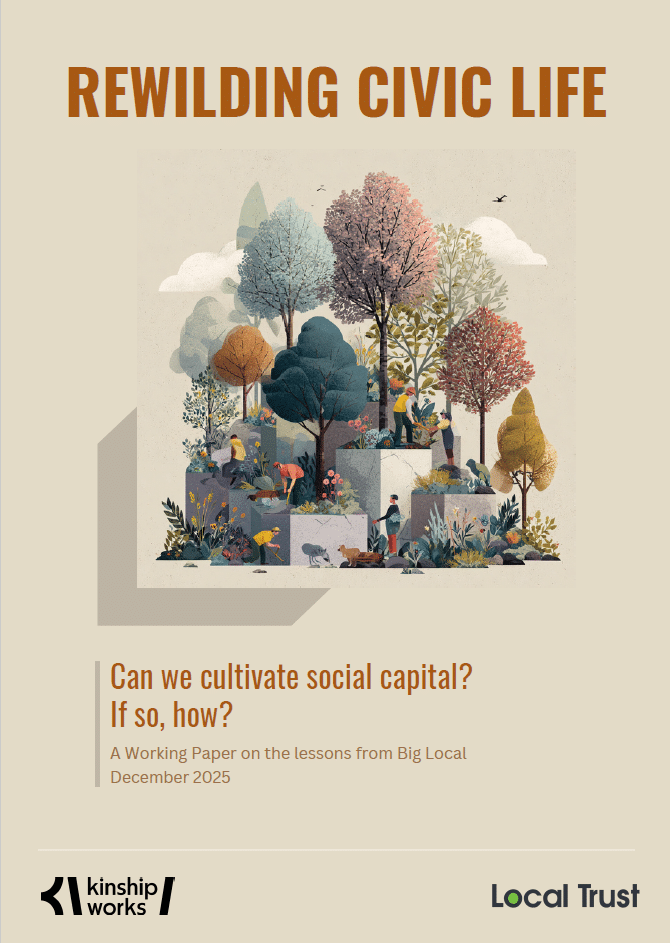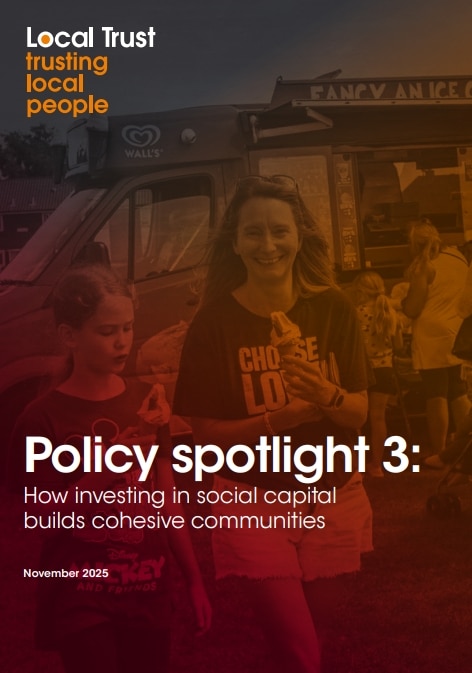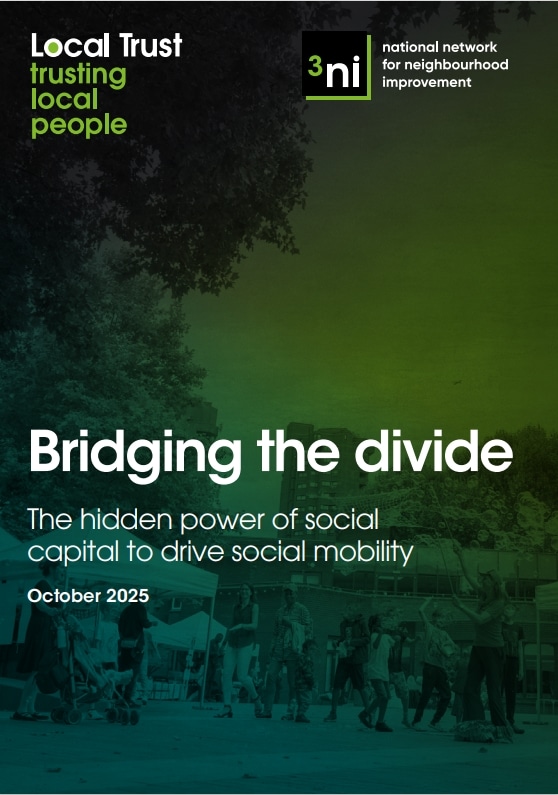Considering areas’ start points, the distance travelled has been considerable.
Since the programme started, 150 communities that had little or no tradition of resident-organising at a community-wide level have seen core groups of active residents and local organisations come together and develop shared visions of more positive futures for their community. Those involved report a growing sense of confidence and self-belief that they will make a real difference over time, as people realise the money is theirs and they can do good things with it. Apart from observing Big Local areas’ own growing sense of confidence, the evaluators’ optimism for the programme comes from seeing evidence of:
- Local visions – areas are embracing the idea that Big Local is about more than £1million and are focusing on working together to bring about lasting change.
- New connections – Big Local is acting as a catalyst to bring together both people and organisations, many of whom have not worked together before.
- Changes in places – very tangible changes can already be seen in many Big Local areas.
- Changes in people – people are doing things now that they didn’t know they could do, growing in confidence, learning new things, making a difference to others and believing they can make Big Local happen.
- Delivery partners’ commitment – partners have a strong commitment to the programme and its values, with enthusiasm for learning and improvements to benefit local communities.
Creating accessible opportunities
- More than £9 million has been allocated as grants directly to Big Local areas. The funding going to areas represents more than 90% of the programme’s overall spend.
- The support made available to areas during the early years has been impressive in its amount and scope and largely felt to be relevant and helpful.
- The collaborative approach that brings together national delivery partners with shared values but different skills, knowledge and strengths has worked.
- The majority of people involved in Big Local areas give their time on a voluntary basis and their other commitments may affect how much time they have to get involved.
Offering local support through a national network
- The support offered through the Big Local reps network is highly effective. More than 80 Big Local reps have been recruited, inducted and trained to support areas.
- Reps are highly valued and serve as a conduit to new ideas and learning, ensure that Big Local is truly resident-led, and provide reassurance and encouragement to residents.
- More than 2,000 places have been taken at Big Local learning events by residents and workers from 145 Big Local areas.
- Areas report benefits from networking with peers – as much to reassure as to learn.
Offering light touch support
- National partners have delivered in line with the programme’s core values and the programme is doing things differently, with light touch support at its heart.
- Some areas felt they needed more directive, or hands on support for short periods.
- The flexibility the light-touch approach offers is recognised as a key enabling factor of resident-led progress; where they are not overly dependent on the programme’s support.
Area journeys so far
- People coming together and beginning to operate effectively as a steering group, or partnership has been an important achievement for areas and supports their development.
- By June 2014, 81 areas had established a Big Local partnership – the average membership is 15, of which 11 are residents. Of those with voting rights, the vast majority (94%) are residents.
- Steering groups and partnerships have often started from no pre-existing basis, generating ambitious goals, and managing some challenging local contexts. More than half now have plans in place and this is significant progress.
- More than 90% of partnership members felt confident they had based their plans on what residents identified as most needed in their area.
- Some areas report feeling they are moving more slowly than they would like. Investing in small tangible, often highly visible projects has helped overcome this.
- The balancing act between ‘delivering now’ and ‘planning ahead’ can be challenging. Concern to use money wisely can mitigate against trying new things and taking risks.
Resident involvement and control
- The first 83 areas to complete their Getting Started activities have reached approximately 94,000 residents. This represents a reach of less than 5% of the local population in some areas, and more than 50% in others.
- A majority of areas report having 15-30 people actively involved as they complete their Getting Started phase – this means that across all 150 areas approximately 3,000 residents are actively involved in driving Big Local forward.
- Getting people involved has been the biggest challenge of the early years. Areas have been creative in how they have tried to engage, but many rely on small numbers and there is concern about being sufficiently reflective of their community.
- The programme feels strongly resident-led in local areas, but inclusion of more diverse groups or those not usually involved in community activity is challenging.
Making the most of local assets
- Several areas are being creative with their local assets – bringing disused buildings back to life and looking at ways to re-purpose or expand the use of an existing community resource or space, rather than creating something new. More than 20 Big Local areas are developing ‘hubs’ and areas are also using in-kind contributions to help make their money go further.
- Big Local areas are making good use of people’s existing skills and talents, seeing local people as valuable assets. Star People also contributes to this work and has increased entrepreneurial activity across 112 Big Local areas.
Changes for those most involved
- Those most actively involved in Big Local have grown in confidence, gained in knowledge and understanding, and learnt new skills, with 72% of partnership members saying they had learnt new things since being involved.
- Local steering groups and partnerships are reporting becoming stronger and more effective. Despite some challenging moments, they feel better able to identify and act on what is needed in their area because of their experience and 85% said being involved in Big Local had enabled them to put their existing skills to good use.
- Residents report they are learning as much from each other as from external agents, with 83% of partnership members indicating those on the journey with them are the main source of their learning.
Changes in the wider community
- While most areas felt it too early to talk about wider changes, early observations include:
- People – coming together more, with more opportunities to learn and socialise.
- Place – new spaces for community activity; improved physical environment.
- Connections – people feeling connected; organisations working better together.
- Some areas felt that residents were starting to have more influence locally, while others felt they could identify ‘a bit of a buzz,’ a change in how people are feeling.
Influencers
- Issues of people and power have often had the most impact on local groups – personality clashes, difficulties getting or keeping people involved, and organisations not supportive of the resident-led ethos have been unhelpful.
- Challenges have been addressed by a combination of factors – including strong leadership, shared responsibility, and support from Local Trust, partners and reps that says an area can take time and it’s okay to stumble or get things wrong, learn and try again.
- Focusing on assets, recognising and building on what already exists provides an important emphasis for Big Local activity. Areas that have the ability to move beyond their local history and focus on the future suggest this helps them progress better.
“Areas told us that the Big Local journey is not an easy one. It can be joyful and exciting, it can be thought-provoking and challenging, but it is rarely if ever described as easy. That being the case the level of achievement, the numbers who have been involved right from the start, and the commitment and hours of effort put in by people in local areas to make Big Local happen is even more remarkable.”
NCVO, Big Local early years evaluation
The evaluation team explored the vast range of data that Local Trust and partners had previously collected to inform their study. They also conducted primary research with:
- members of Big Local steering groups and partnerships, who took part in a survey (236 respondents), and review activities, workshops and case studies
- Big Local reps, who piloted activities and responded to a survey (covering 86 of the 150 areas)
- the Local Trust team and national partners.
The Big Local early years evaluation was conducted by the National Council for Voluntary Organisations (NCVO), Office for Public Management (OPM) and Institute for Volunteering Research (IVR)
Wordle which captures the popular words in this summary:





